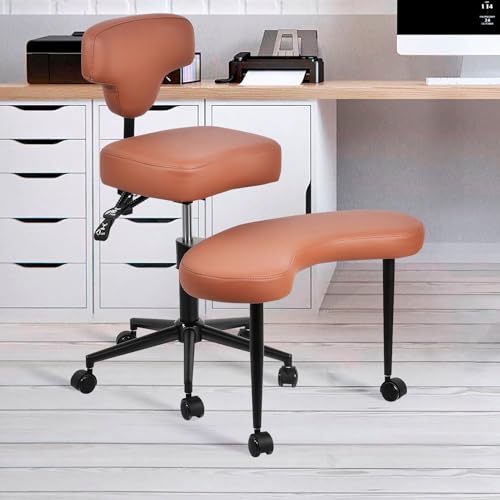29 Office Accent Walls for Your Workspace. This guide explores innovative ways to transform your office with a focal wall, offering creative ideas and practical tips to enhance aesthetics, boost productivity, and infuse personal style into your professional environment.
The Power of a Statement: Why Office Accent Walls Matter
In today’s dynamic work environment, whether in a corporate setting or a home office, the aesthetics of a workspace significantly impact productivity, mood, and overall well-being. A plain, uninspired office can feel monotonous, hindering creativity and focus. This is where the strategic use of Office Accent Walls becomes a powerful tool. It transforms a functional area into an inspiring and visually engaging space.
An Office Accent Wall is a single wall within a room that features a different color, texture, material, or pattern from the other walls. Its purpose is to create a focal point, add visual interest, and inject personality. This design element can dramatically alter the perception of a space. It makes a room feel more intentional and dynamic. It directs attention.
Beyond aesthetics, Office Accent Walls offer practical benefits. They can define zones within an open-plan office. They can highlight specific features like a monitor setup or a display shelf. They can even influence mood, using colors associated with creativity or calm. Investing in a well-designed accent wall is a cost-effective way to refresh your workspace. It elevates the professional atmosphere. It ultimately contributes to a more stimulating and enjoyable work environment.
Key Principles for Designing Effective Office Accent Walls
Creating a successful Office Accent Wall relies on understanding a few fundamental design principles. These guide your choices, ensuring the wall enhances, rather than overwhelms, your workspace.
Choosing the Right Wall: The Focal Point
Select the wall that naturally serves as a focal point or the one you want to draw attention to. This is often the wall behind your desk, a wall opposite the entrance, or a wall with a significant architectural feature like a large window. The chosen wall should be free of excessive doors or windows that might break up the design. It should be visible upon entering the room. This strategic placement ensures the accent wall has its intended impact, becoming a true centerpiece for your Office Accent Walls.
Color Theory: Setting the Mood and Enhancing Focus
Color significantly influences mood and perception. Consider the psychological effects of colors when choosing your accent wall hue.
Blues and Greens: Often associated with calmness, productivity, and focus. Ideal for concentration.
Yellows: Can be energizing and optimistic, but avoid overly bright shades that might be distracting.
Neutrals (Charcoal, Greige): Provide sophistication and depth without overwhelming the space.
Warm tones (Terracotta, Deep Red): Can be stimulating but use sparingly in a workspace to avoid over-agitation.
The accent color should complement, not clash with, the existing wall colors and office decor.
Texture and Pattern: Adding Depth and Interest
Beyond solid color, Office Accent Walls can incorporate texture and pattern for added visual interest.
Textured Paint: Creates subtle dimension.
Wallpaper: Offers a vast array of patterns, from subtle geometrics to bold murals.
Wood Paneling: Adds warmth and a natural feel.
Brick or Stone Veneer: Provides an industrial or rustic aesthetic.
Ensure the pattern or texture chosen is not overly busy or distracting, especially in a work environment. The goal is to stimulate, not overwhelm.
Lighting: Highlighting the Accent Wall
Proper lighting enhances the impact of your Office Accent Walls. Consider:
Recessed lighting: Can wash the wall with light.
Wall sconces: Add a decorative element and provide ambient light.
Picture lights: Highlight artwork or specific wall features.
Ensure the lighting complements the accent wall’s texture or color. Effective lighting draws attention to the wall and integrates it seamlessly into the overall room design.
29 Innovative Office Accent Walls for Your Workspace: Inspire Your Design
These creative ideas offer diverse ways to design an Office Accent Wall that reflects your style, boosts your focus, and transforms your workspace.
1. Deep Navy Blue: Classic and Concentrated
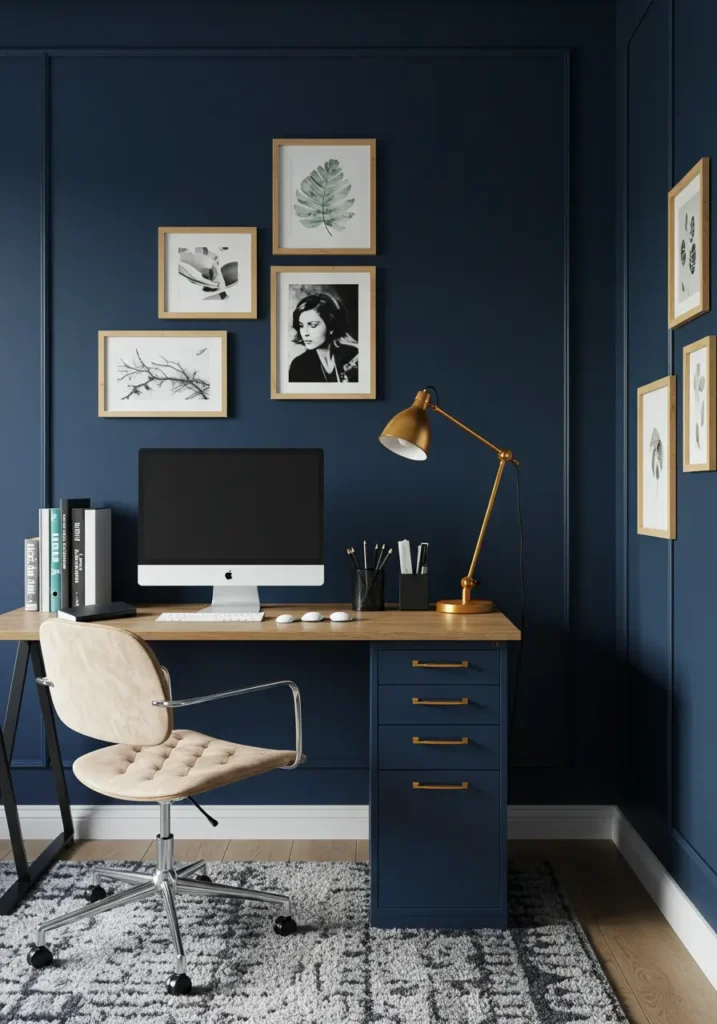
Paint one wall a deep navy blue. This color exudes sophistication and promotes focus, making it ideal for a workspace. It pairs beautifully with light woods and metallic accents.
2. Chalkboard Wall: Functional Creativity
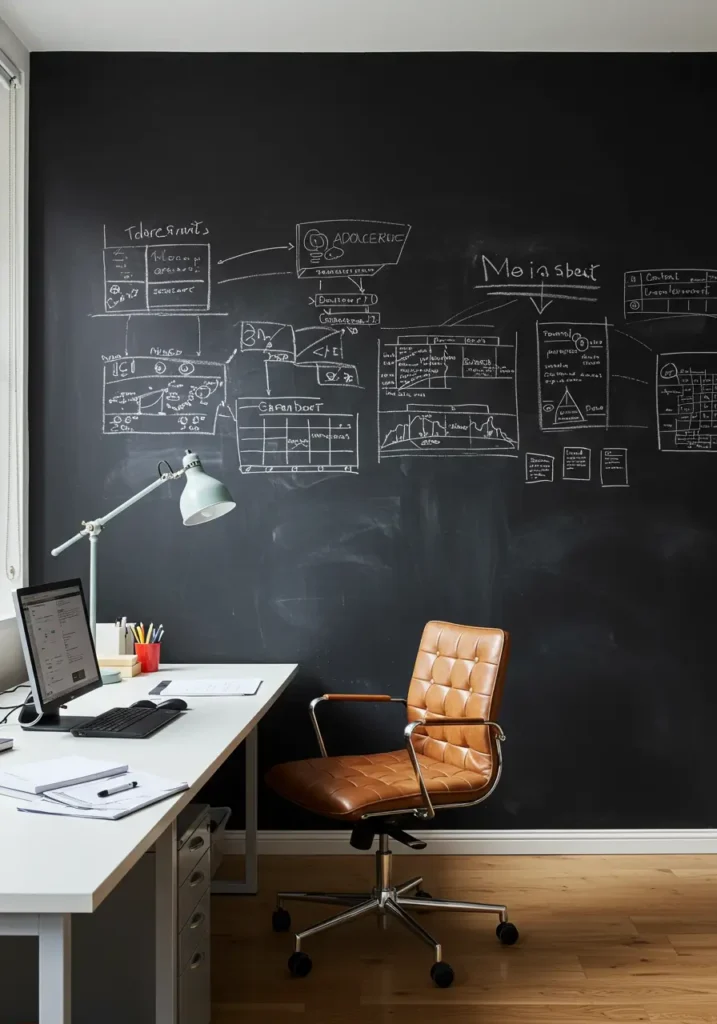
Cover a wall with chalkboard paint. This creates a functional accent wall for brainstorming, jotting down ideas, or sketching designs. It adds an interactive and creative element to your office.
3. Wood Slat Paneling: Modern and Textured
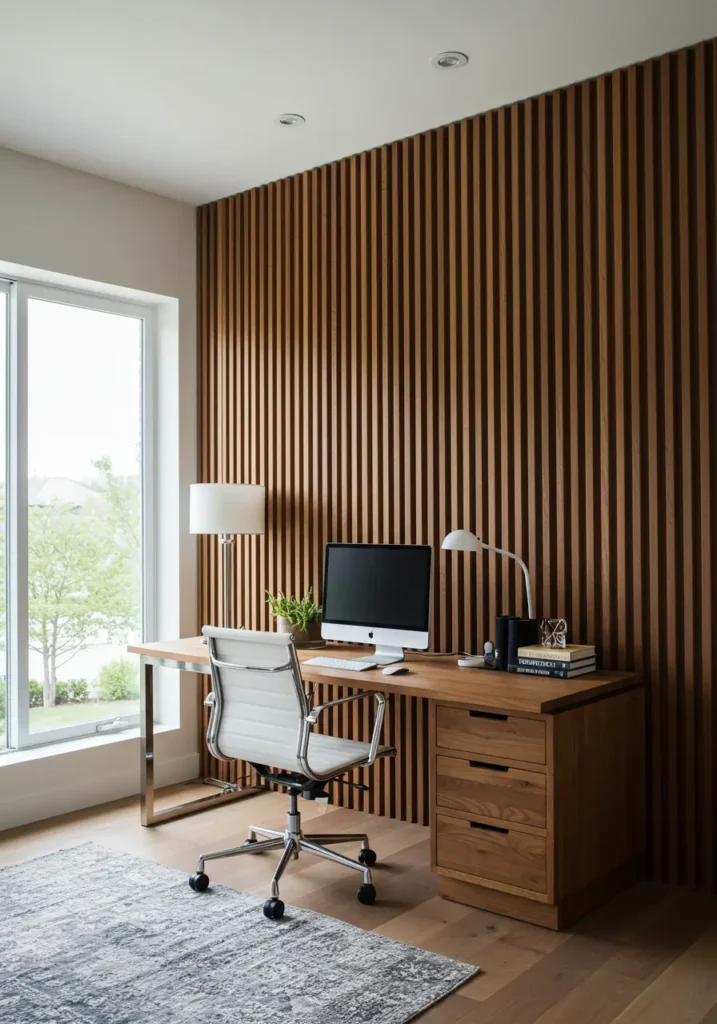
Install vertical or horizontal wood slats for a modern, textured look. This adds warmth and architectural interest. It can also subtly improve acoustics in the room.
4. Geometric Painted Mural: Artistic Statement
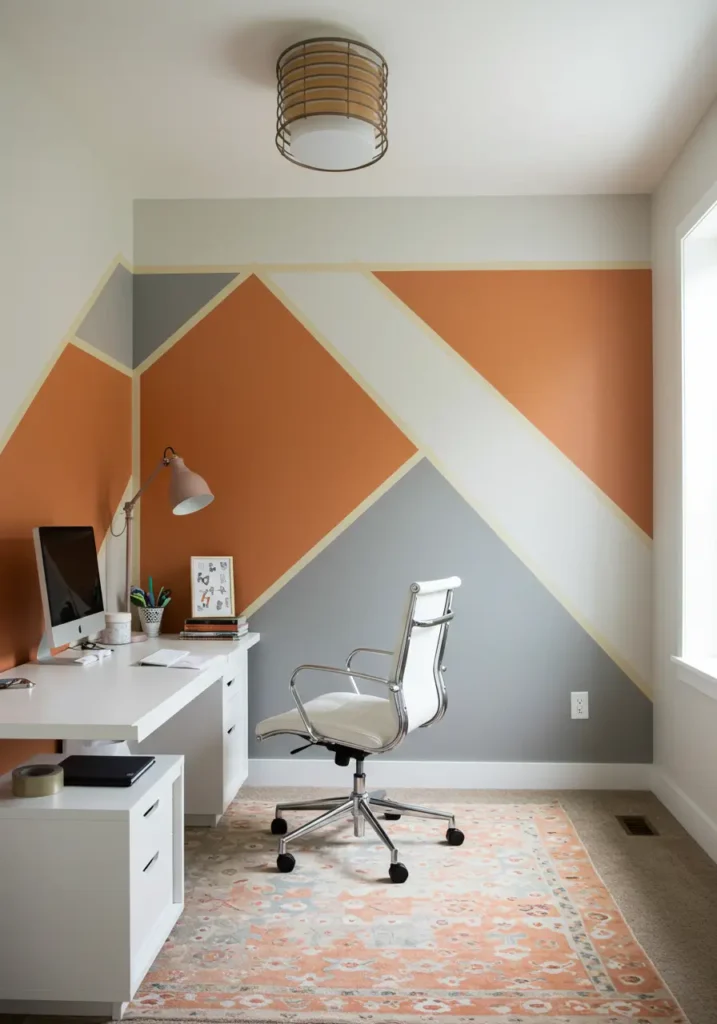
Create a custom geometric mural using painter’s tape and two or three complementary paint colors. This adds an artistic and dynamic focal point.
5. Corkboard Wall: Practical and Pin-Worthy
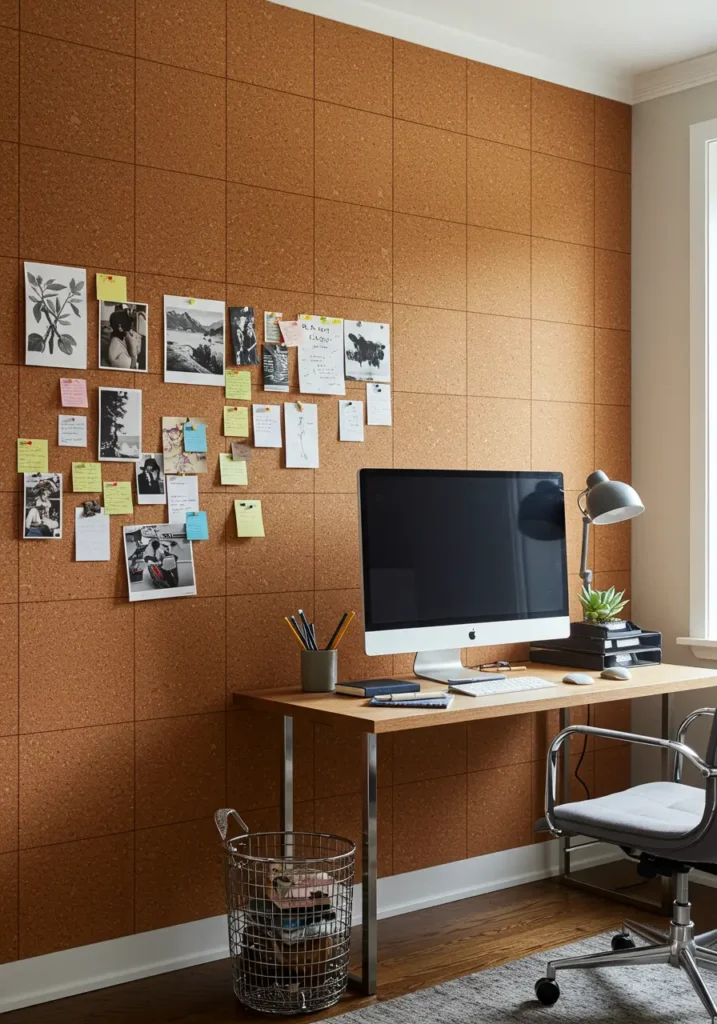
Cover an entire wall, or a large section, with cork tiles or a cork roll. This creates a functional accent wall for pinning notes, inspiration, and photos. It is both practical and adds texture.
6. Textured Wallpaper: Subtle Elegance
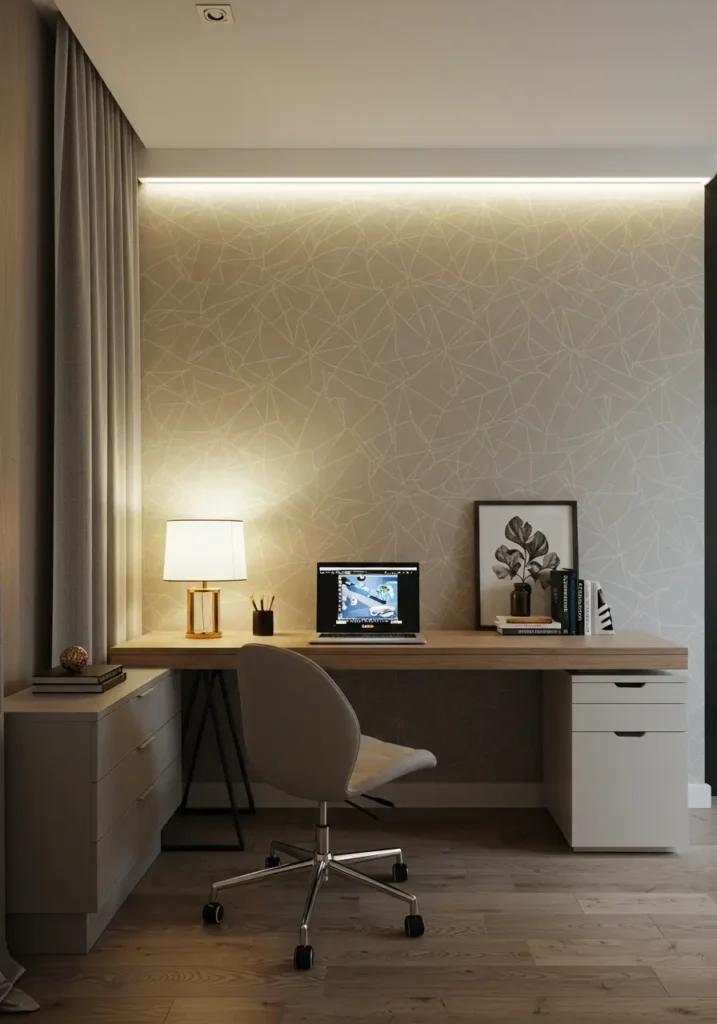
Choose a wallpaper with a subtle texture, like grasscloth, linen-look, or a gentle geometric pattern. This adds elegance and depth without overwhelming the space.
7. Gallery Wall of Framed Art: Personal and Inspiring
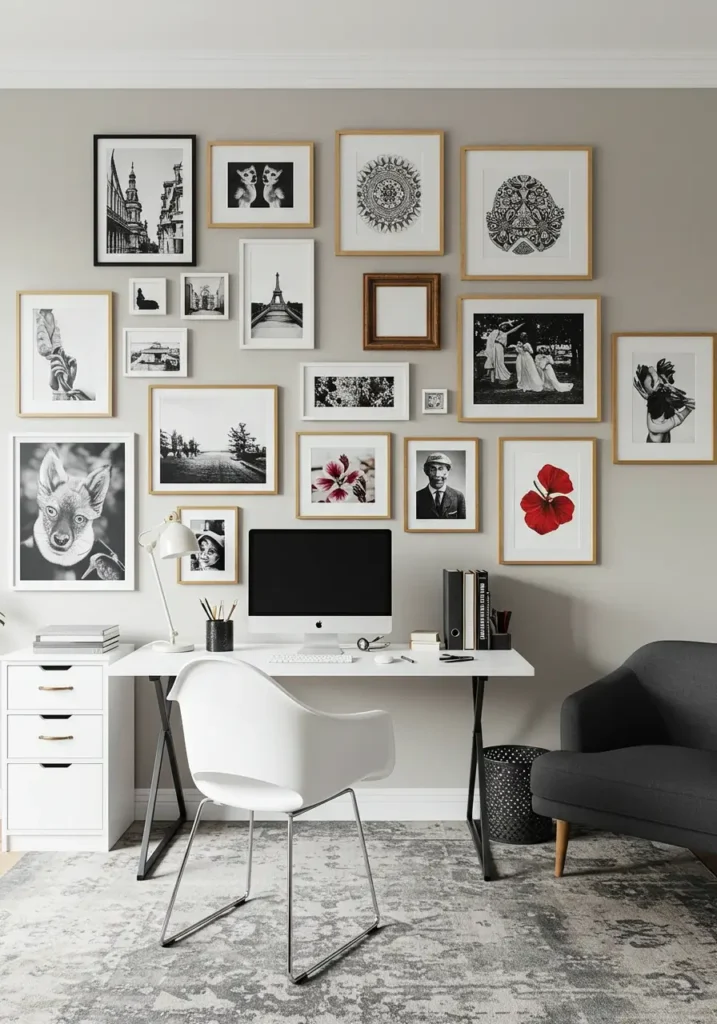
Curate a collection of framed artwork, prints, or photographs to create a full gallery wall. Choose a cohesive theme or color palette. This personalizes the space and offers visual inspiration.
8. Exposed Brick Veneer: Industrial Chic
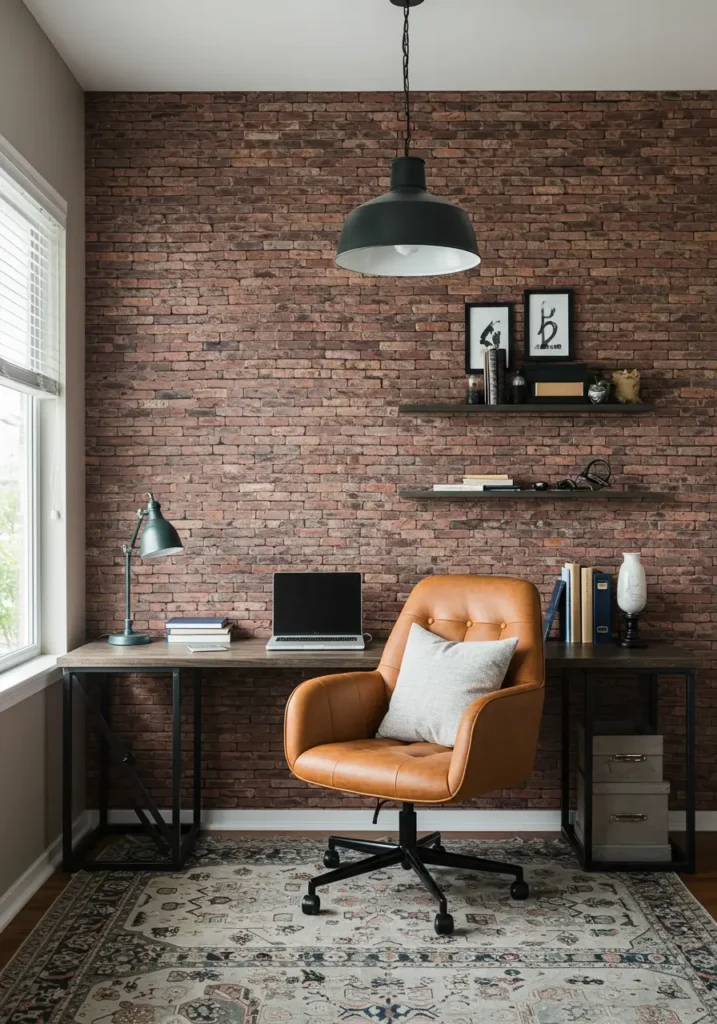
Apply a faux brick or real brick veneer to one wall. This adds an industrial, rustic, or urban loft aesthetic. It provides a strong textural element and character.
9. Removable Wallpaper: Flexible Design
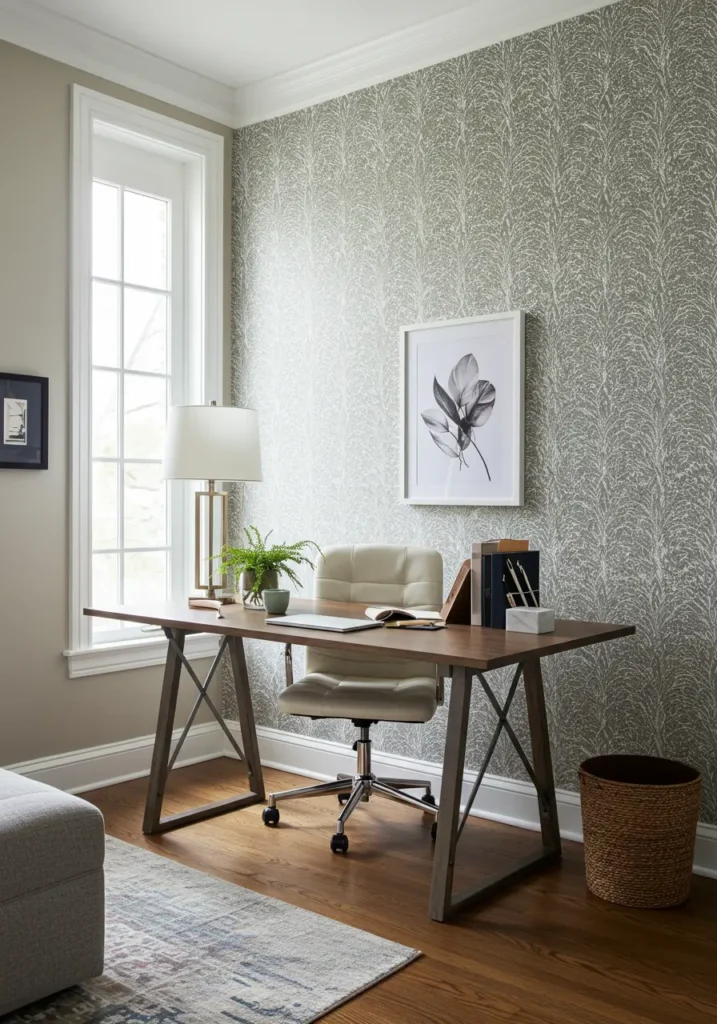
Use removable wallpaper for a bold pattern or unique texture. This allows for easy updates or changes without the commitment of permanent wallpaper. It is perfect for rented spaces or changing tastes.
10. Pegboard System: Organized Functionality
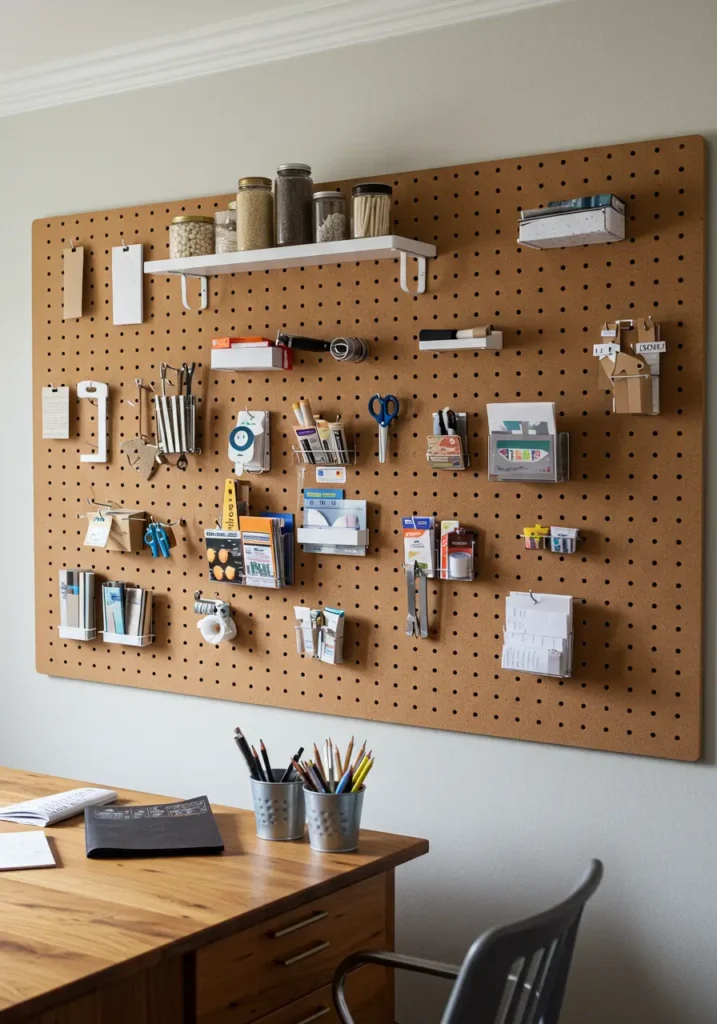
Install a large pegboard system on an accent wall. Use a variety of hooks, shelves, and bins to organize office supplies, tools, or craft items. This provides highly customizable and functional storage. This is a great choice for Office Accent Walls.
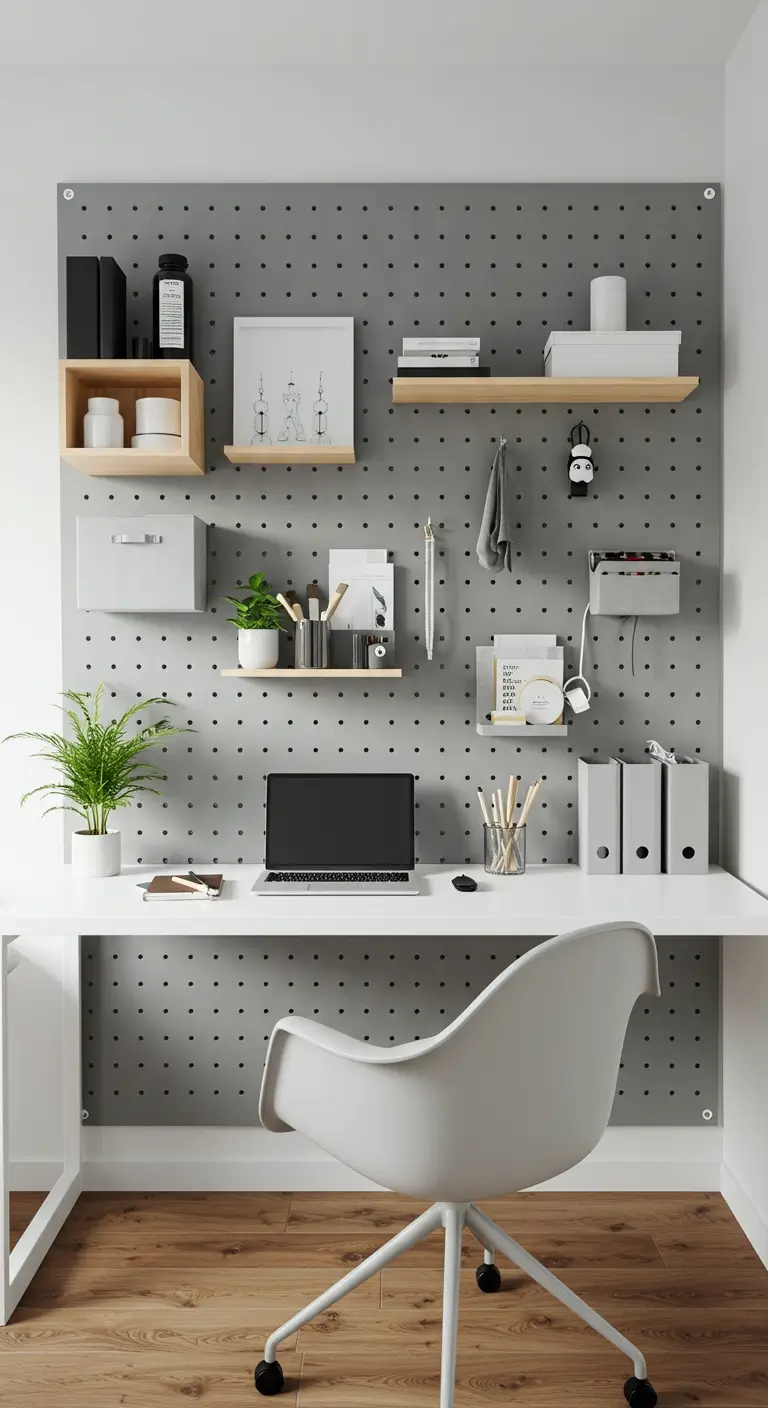
11. Vertical Garden Wall: Biophilic Touch
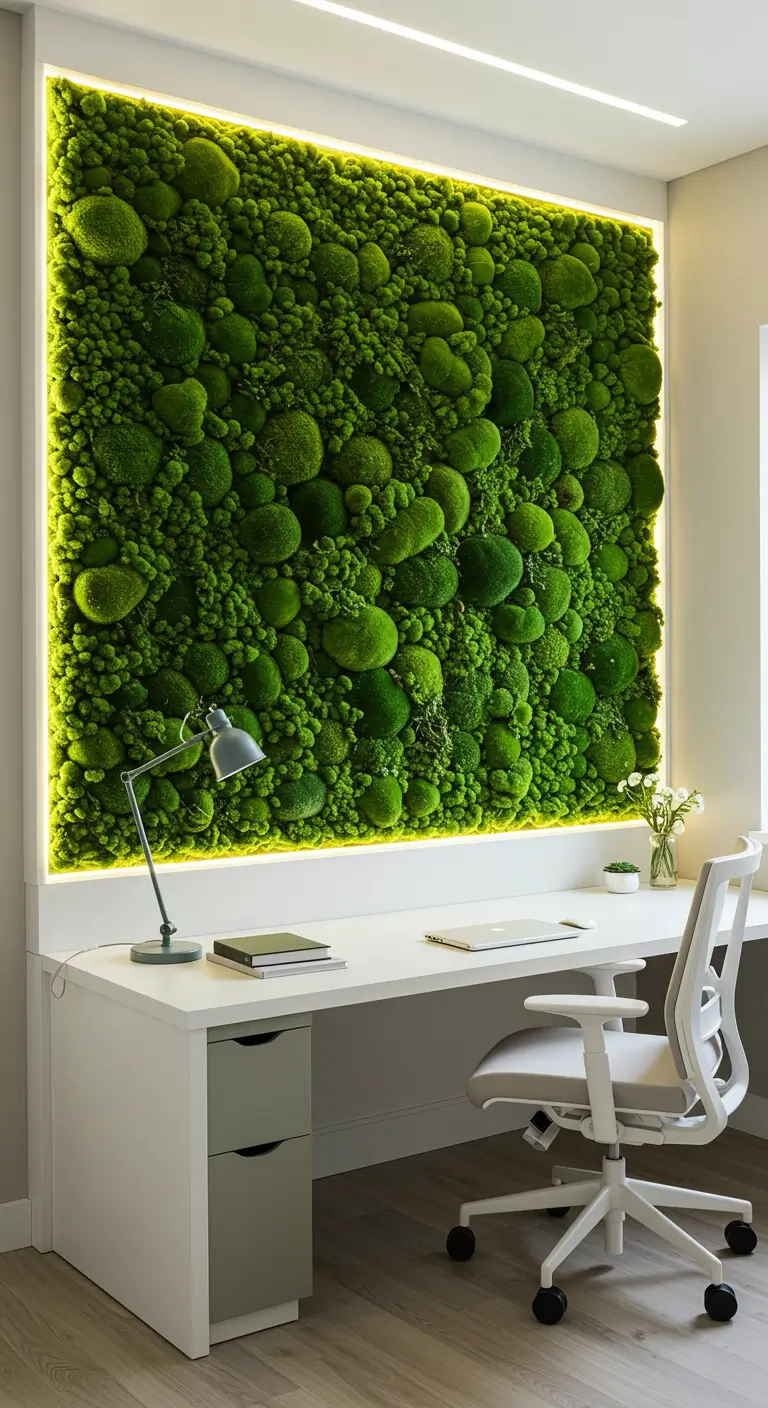
Install a living plant wall or a series of wall-mounted planters. This brings nature indoors, improves air quality, and adds a calming biophilic element to your workspace.
12. Ombre Painted Wall: Gradual Color Transition
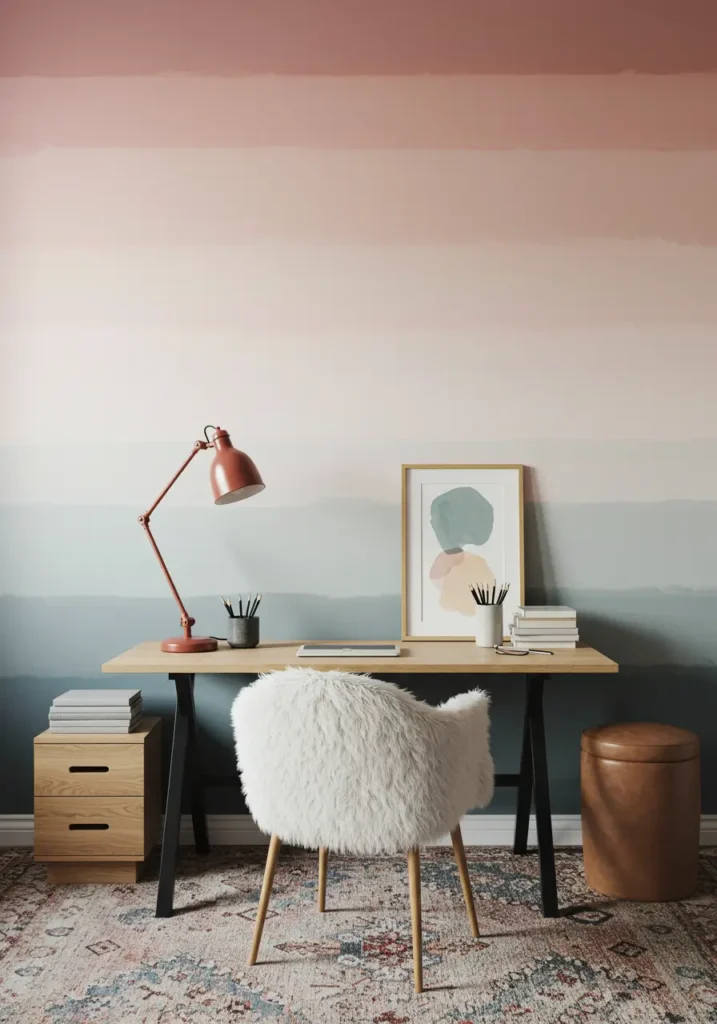
Create an ombre effect by blending two or three colors vertically or horizontally on the wall. This creates a soft, gradient color transition that adds visual interest and a sense of calm.
13. Fabric Wall Covering: Softness and Texture
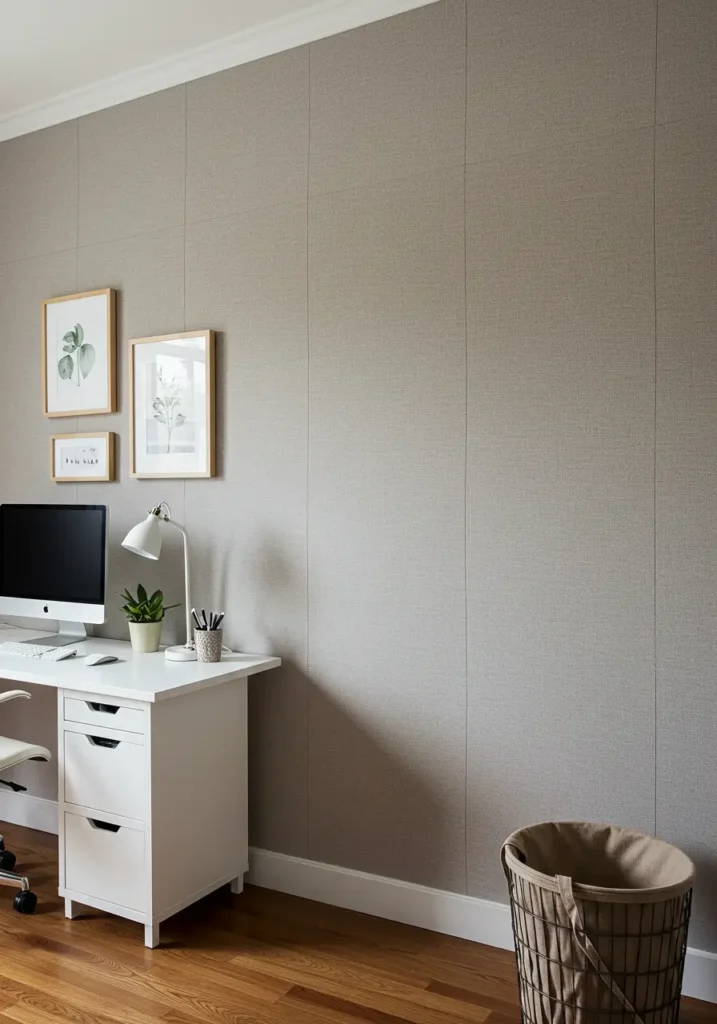
Stretch fabric over one wall for a soft, textural accent. Choose a fabric with an interesting weave or subtle pattern. This adds warmth and can improve acoustics.
14. Built-In Shelving: Integrated Storage
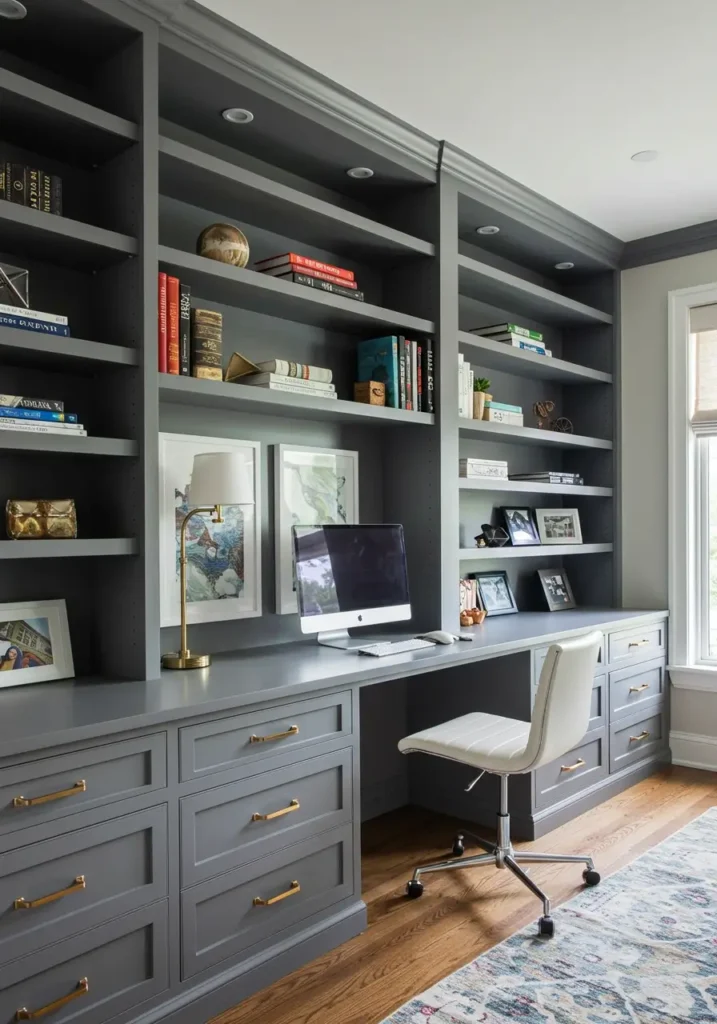
Install custom built-in shelves or bookcases along an entire wall. This provides extensive storage and display space. Paint the shelves a contrasting color or use a unique material for the back panel to make it an accent.
15. Mirrored Panels: Expand and Reflect
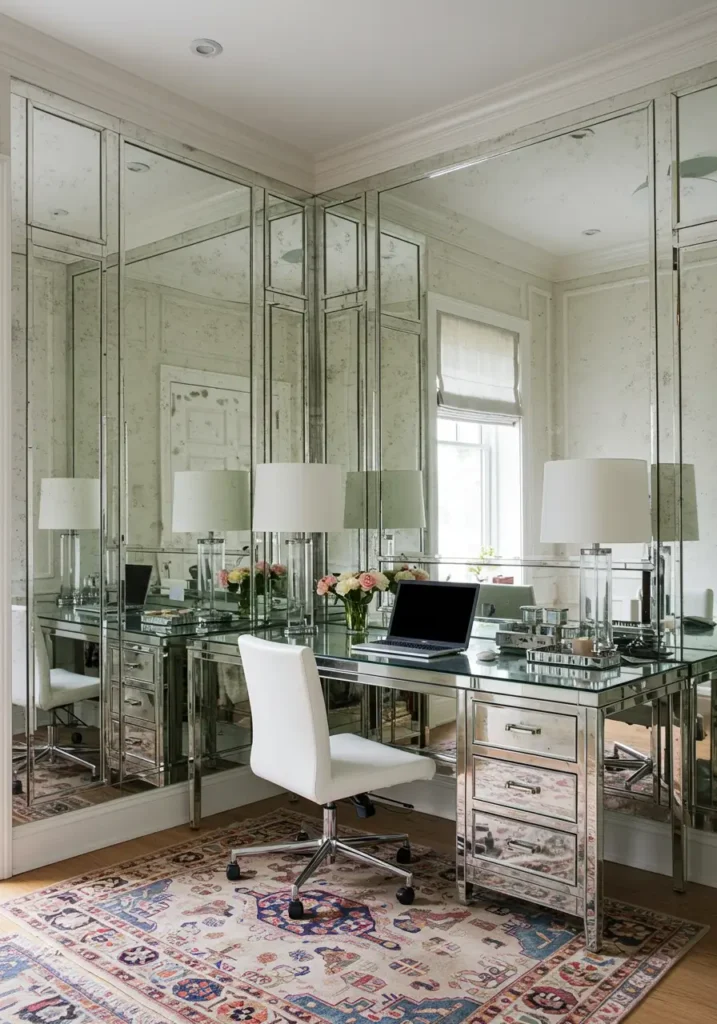
Apply mirrored panels or a large framed mirror to one wall. This creates the illusion of more space and reflects light, brightening the room. It adds a touch of glamour and sophistication.
16. Textured Plaster or Stucco: Organic Finish
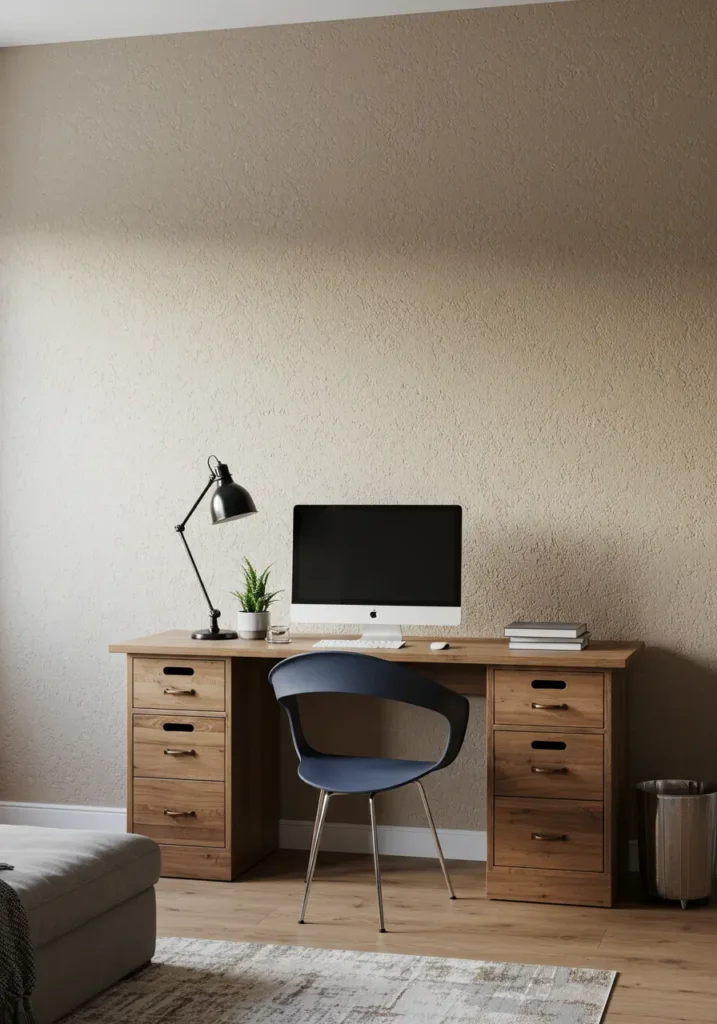
Apply a textured plaster or stucco finish for an organic, artisanal look. This adds depth and a unique tactile quality to the wall. This creates a warm, Mediterranean, or modern minimalist vibe.
17. Bold Geometric Bookshelf: Functional Art
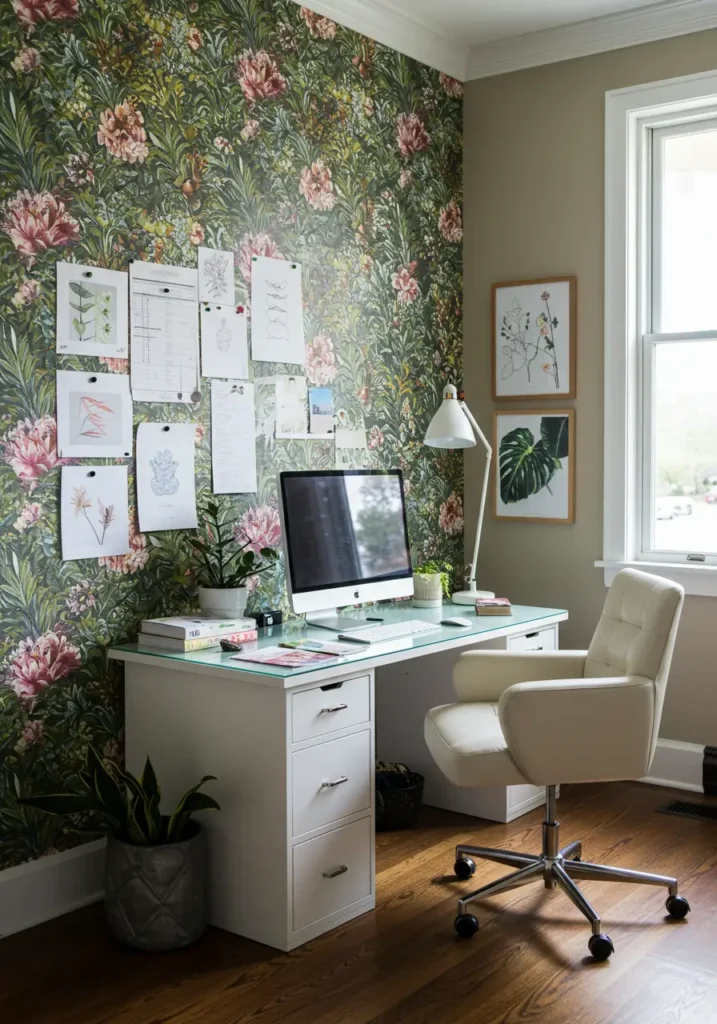
If you have an open bookshelf, paint the back wall a bold color or apply a striking wallpaper to make it pop. Arrange books and decor by color or pattern to create a visually appealing display. The bookshelf becomes functional art.
18. Acoustic Panels with Design: Sound Control and Style
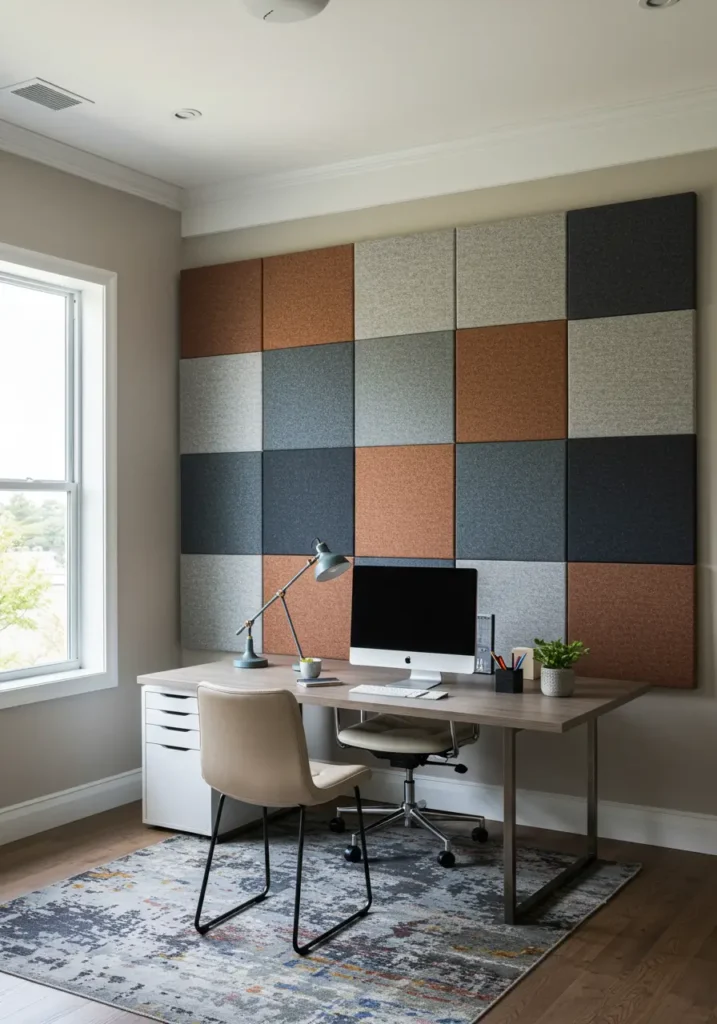
Install decorative acoustic panels. These panels reduce echo and improve sound quality in the room. They come in various colors and patterns, allowing them to double as a stylish accent wall. This provides a functional and aesthetic solution.
19. Custom Whiteboard/Glass Board: Collaborative Functionality
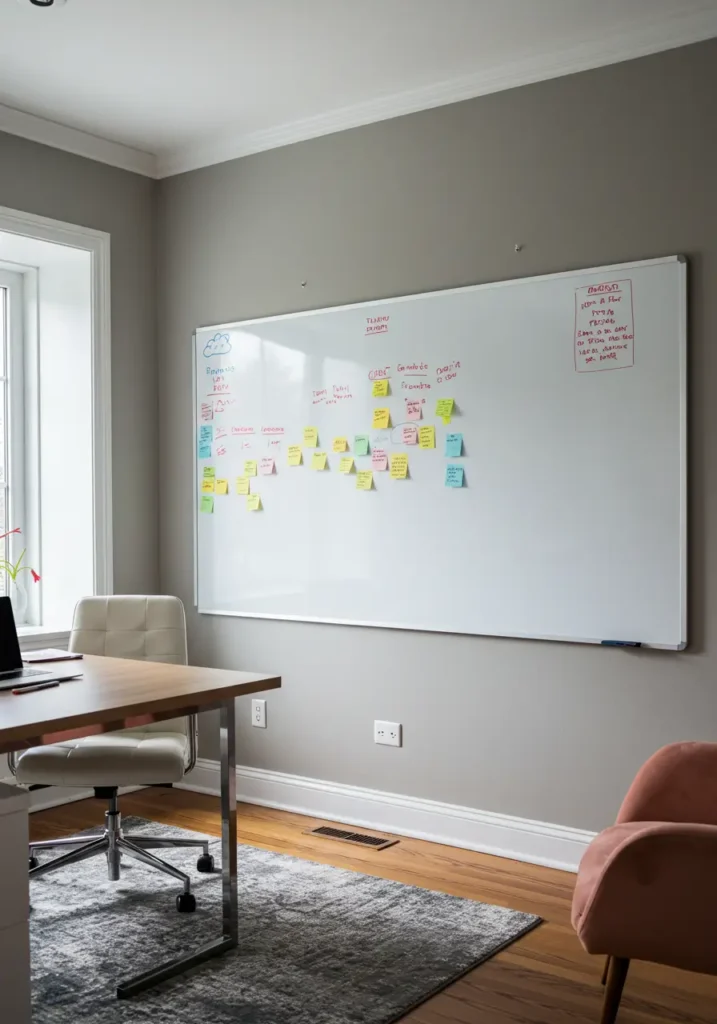
Mount a large whiteboard or glass board on an accent wall. This provides a functional space for notes, brainstorming, or project planning. It creates a sleek, modern look that promotes collaboration.
20. Board and Batten Paneling: Classic Architectural Detail
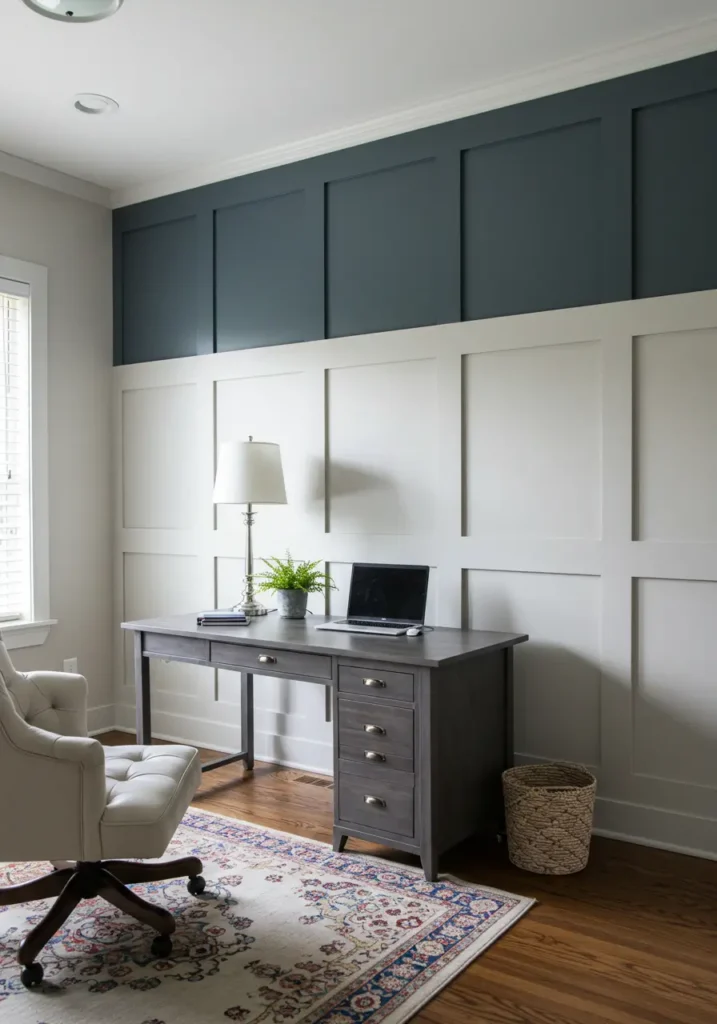
Install board and batten paneling up to a certain height on the wall. Paint it a contrasting color from the wall above. This adds classic architectural detail and visual interest. It creates a timeless look.
21. Gradient Painted Wall: Subtle Transition
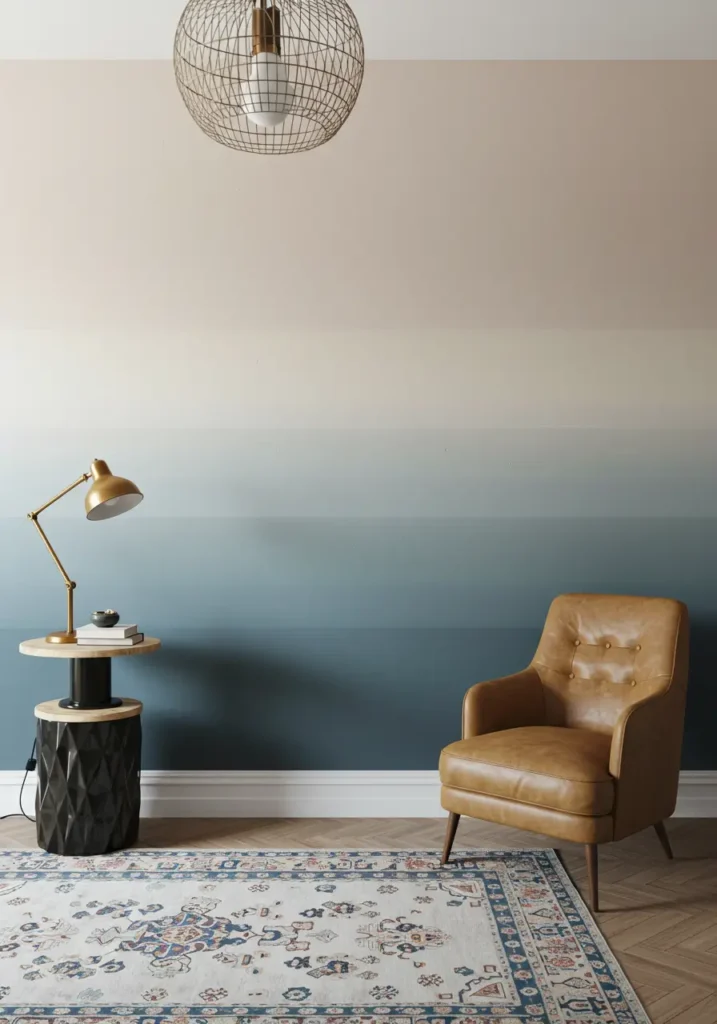
Similar to ombre, a gradient wall uses a very subtle transition between colors, often from light to dark or vice versa. This creates a soft, calming effect and adds depth to the room without being overly bold.
22. Cork Wall Tiles in a Pattern: Modern Texture
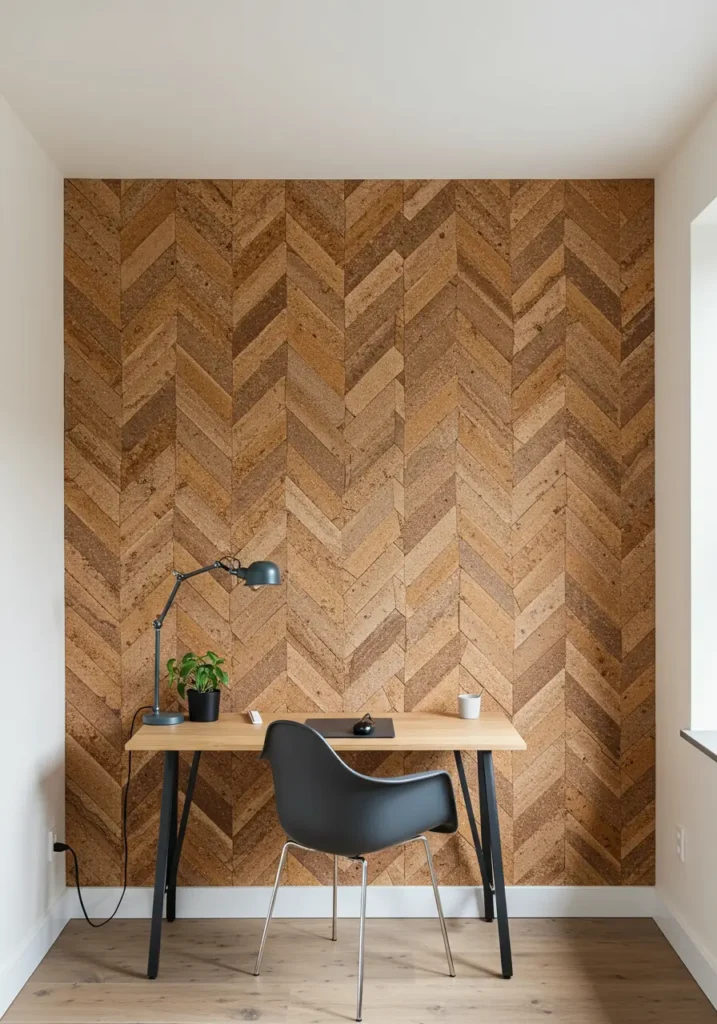
Use individual cork wall tiles to create a unique pattern. Arrange them in a herringbone, chevron, or checkerboard design. This adds texture, warmth, and sound absorption. It offers a modern, sustainable accent for Office Accent Walls.
23. Photo Collage Wall: Personal Storytelling
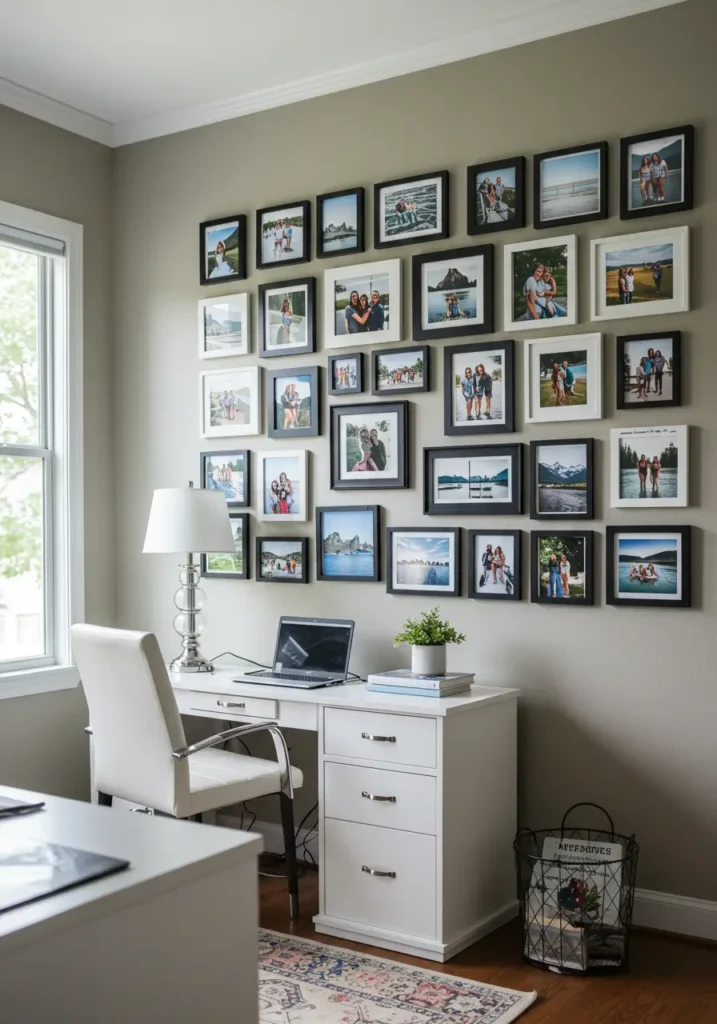
Create a large photo collage wall featuring personal photos, travel memories, or inspiring images. Use various frame sizes and arrangements for a dynamic display. This personalizes the space and provides visual comfort.
24. Faux Concrete or Metallic Paint Finish: Industrial Edge
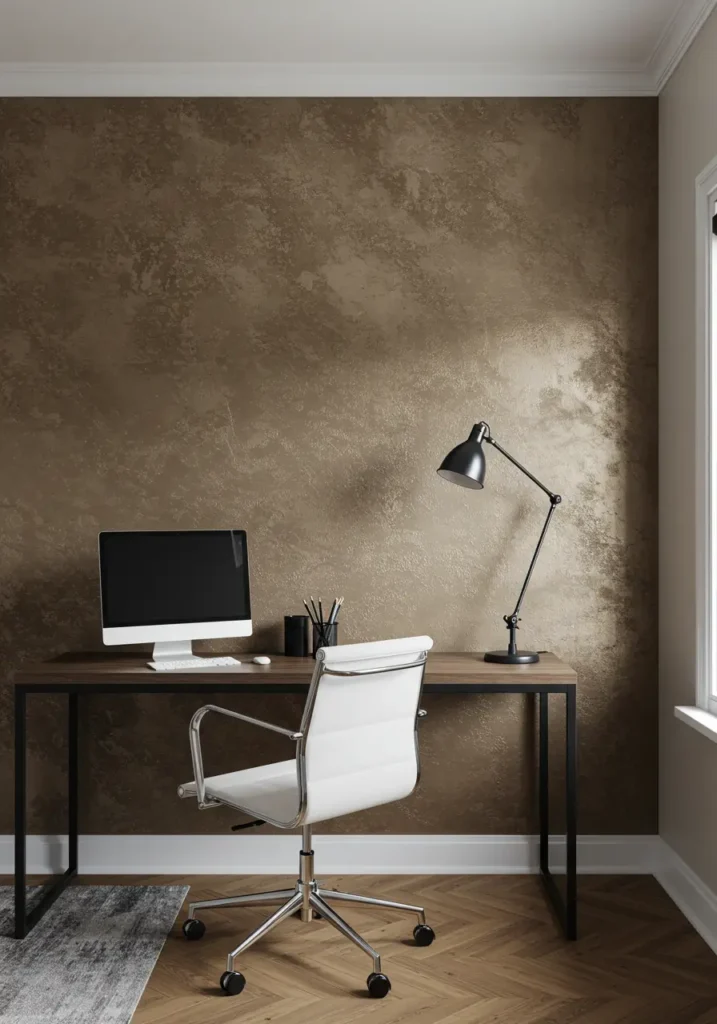
Apply a faux concrete finish or a metallic paint to one wall. This creates an industrial, urban, or sophisticated contemporary look. It adds texture and a unique sheen that catches the light.
25. World Map Wall Mural: Inspiring Exploration
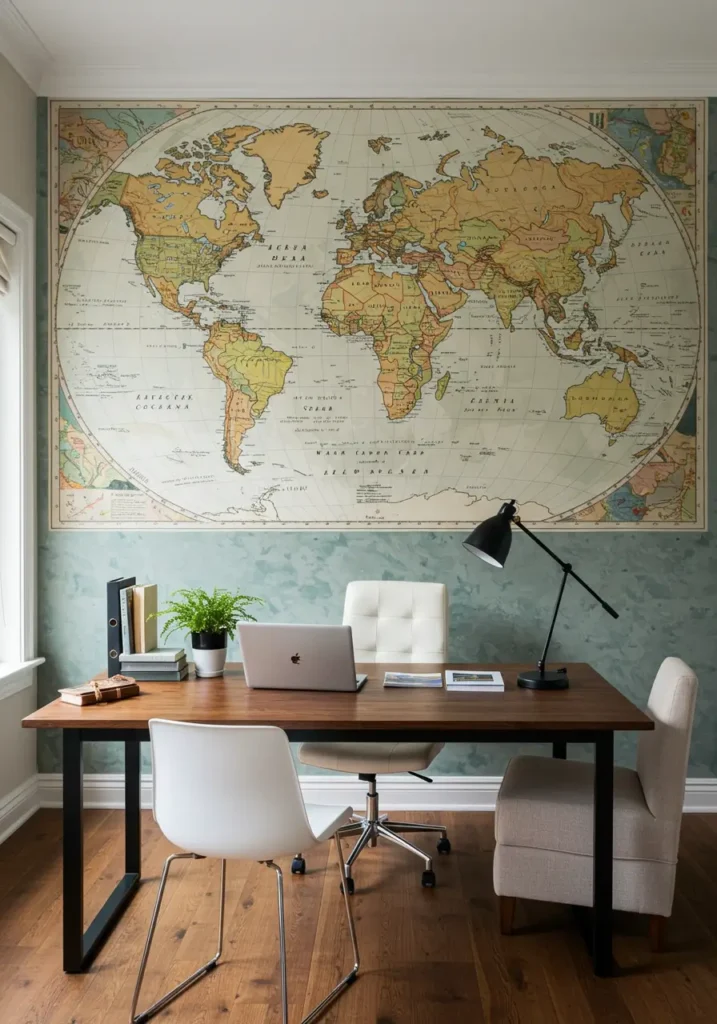
Install a large wall mural featuring a detailed world map. This can be a painted mural, a wallpaper mural, or a framed map. It inspires travel, global thinking, and provides a unique visual focal point.
26. Shiplap Paneling: Coastal or Farmhouse Vibe
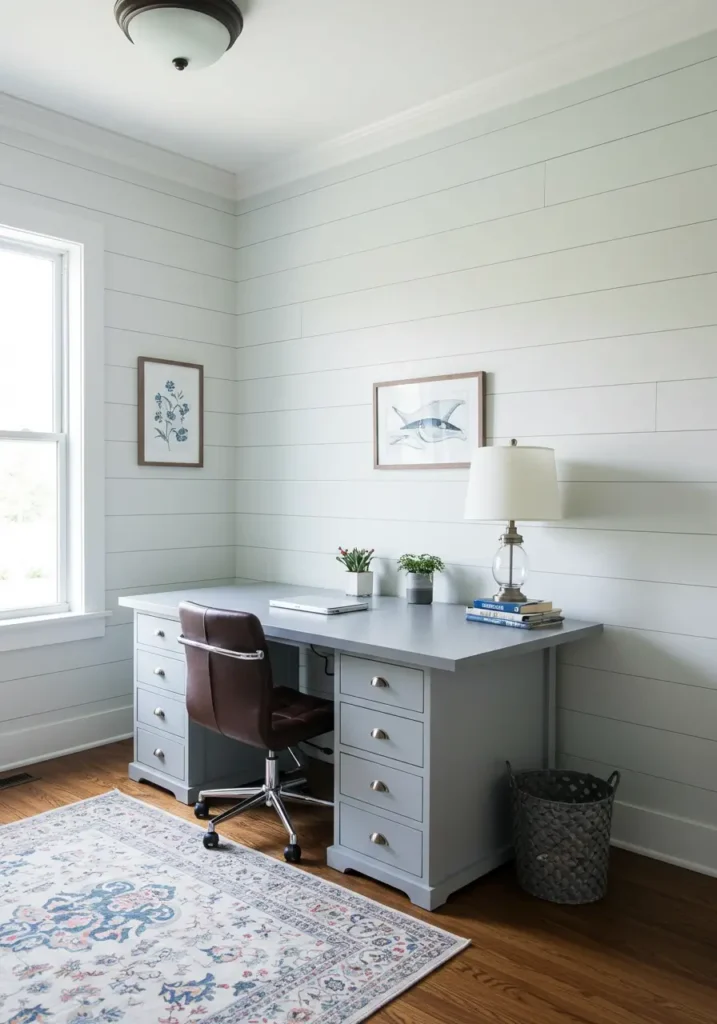
Install horizontal shiplap paneling on an accent wall. Paint it white for a classic farmhouse look or a light blue for a coastal feel. This adds texture and architectural charm, creating a cozy and inviting atmosphere.
27. Custom Art Niche with Spotlight: Highlight a Masterpiece
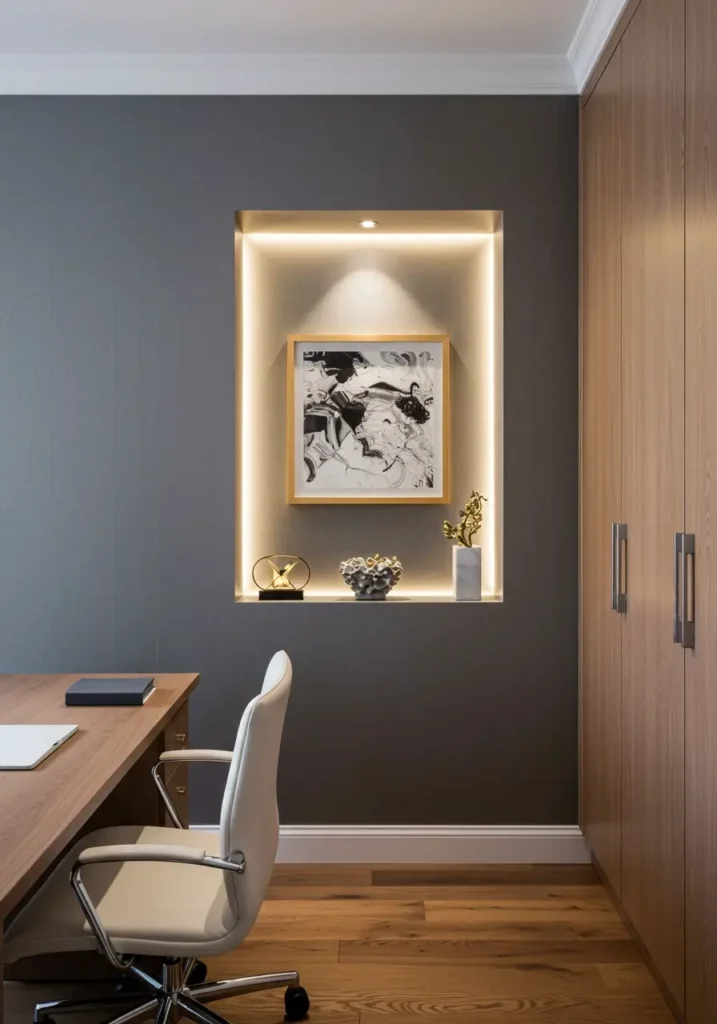
Build a recessed niche into an accent wall to display a special piece of art or sculpture. Add integrated lighting (e.g., a small spotlight) to highlight the object. This creates a dramatic and sophisticated focal point.
28. Bold Floral or Botanical Wallpaper: Natural Serenity
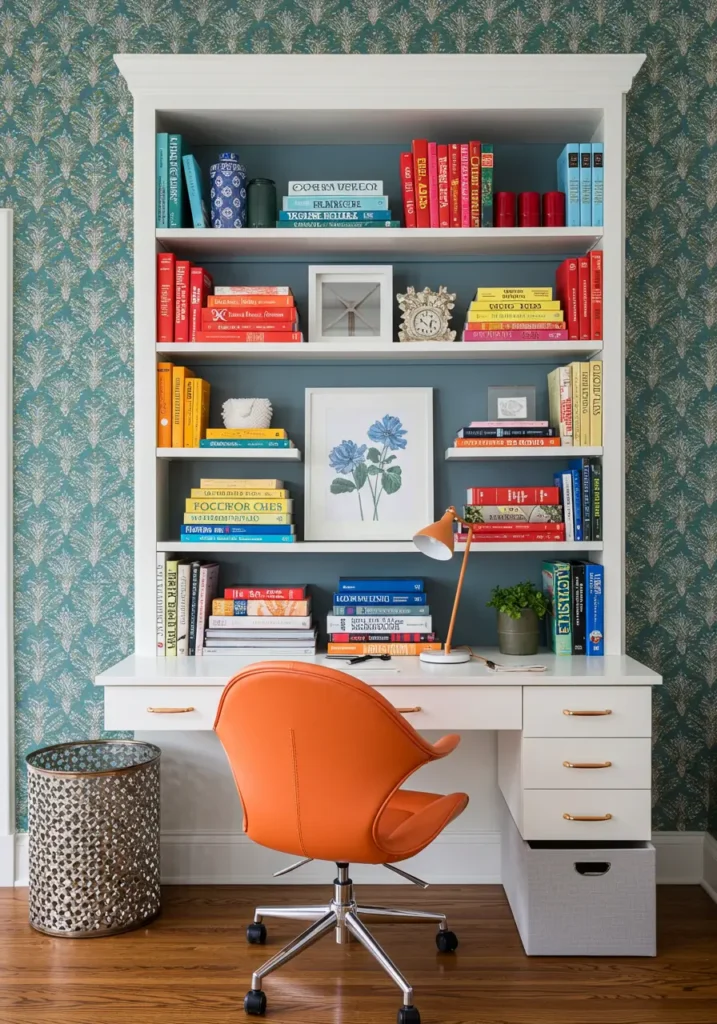
Choose a large-scale floral or botanical wallpaper pattern. This brings nature indoors, adds color, and creates a serene or vibrant atmosphere, depending on the print. It offers a refreshing and aesthetically pleasing backdrop for Office Accent Walls.
29. Statement Bookshelf with Back Panel Contrast
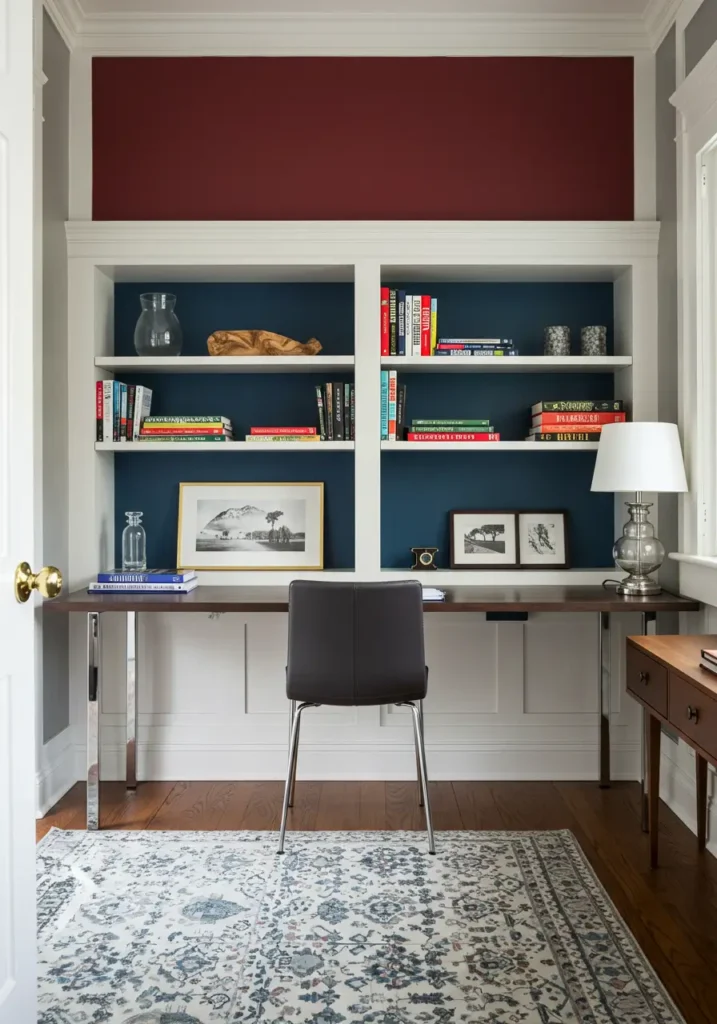
If you have an open bookshelf, paint the back panel of the shelves a contrasting, bold color. This creates an accent within the bookshelf itself, drawing attention to your book collection and decor items. It is a subtle way to add an accent.
Also Read: WALL DECOR IDEAS: 20 CREATIVE AND CUTE
Budgeting for Office Accent Walls: Cost-Effective Transformations
Creating an Office Accent Wall can range from a budget-friendly DIY project to a professional installation. Strategic budgeting helps you achieve your vision without overspending.
Affordable DIY Options (Under $100)
For a tight budget, focus on paint. A single gallon of paint (in a bold color, ombre, or geometric pattern) can dramatically transform a wall. Using painter’s tape for patterns is inexpensive. Affordable gallery wall prints or a large cork roll also provide visual impact for under $100. These are excellent ways to create Office Accent Walls economically.
Mid-Range Projects ($100-$500)
A mid-range budget allows for more material-based accents. This could include purchasing quality removable wallpaper, materials for simple wood slat paneling, or a large, high-quality pegboard system. It might also cover hiring a professional painter for a single accent wall. This tier offers enhanced aesthetic appeal and durability.
Premium Materials and Professional Installation ($500+)
A larger budget opens doors to more complex and luxurious Office Accent Walls. This includes professional installation of permanent wallpaper (e.g., silk, custom murals), genuine wood paneling, brick/stone veneer, or custom built-in shelving with integrated lighting. Engaging an interior designer for a bespoke accent wall also falls into this category. This represents a significant investment for a truly unique and high-impact design.
Caring for Your Office Accent Walls: Maintaining Impact
Proper care ensures your Office Accent Walls maintain their beauty and impact for years. Consistent maintenance protects your design investment.
Regular Cleaning and Dusting
Dust your accent wall regularly, just like your other walls. Use a soft, dry cloth or a duster. For painted walls, wipe clean with a damp cloth and mild soap for smudges. For textured surfaces like wallpaper or wood panels, follow specific cleaning instructions to avoid damage. Regular cleaning preserves the vibrancy of colors and textures.
Protect from Damage and Direct Sunlight
Protect your Office Accent Walls from physical damage. Avoid placing furniture directly against them if it might cause scuffs. Use felt pads under items on shelves. Prolonged direct sunlight can fade colors or patterns over time. Consider UV-protective window films or blinds if the wall receives intense sun exposure. This proactive approach ensures longevity.
Address Issues Promptly: Timely Repairs
Address any issues like scuffs, chips in paint, or peeling wallpaper promptly. Minor repairs prevent small problems from escalating and becoming more noticeable. For specialized materials like veneer or custom murals, consult a professional for repairs. Timely maintenance preserves the flawless appearance and impact of your accent wall.
Latest Innovations Influencing Office Accent Walls
The world of interior design continually evolves, bringing new materials, technologies, and approaches that enhance the possibilities for creating unique and functional Office Accent Walls.
Smart Lighting Integration with Dynamic Effects
Innovations in smart lighting allow for dynamic illumination of Office Accent Walls. LED strips, smart spotlights, or color-changing bulbs can be programmed to create different moods or highlight specific textures throughout the day. This technology allows for personalized ambiance, enhances focus, or even serves as a visual timer for breaks. It transforms the wall into an interactive element.
Sustainable and Recycled Materials
A growing trend focuses on environmentally conscious wall treatments. Manufacturers offer accent wall materials made from recycled plastics, reclaimed wood, cork, or plant-based fibers. These choices reduce environmental impact and often feature unique textures. This aligns design with sustainability values, offering eco-friendly options for Office Accent Walls.
Augmented Reality (AR) for Design Visualization
Augmented Reality (AR) apps revolutionize how you visualize accent walls. Users can virtually “try on” different paint colors, wallpaper patterns, or material finishes directly on their wall using a smartphone or tablet. This reduces uncertainty and helps make confident design decisions before any physical changes begin. It provides a realistic preview.
Making Your Final Decision on Office Accent Walls
Designing an Office Accent Wall is a powerful way to personalize your workspace and boost productivity. Focus on selecting a concept that truly reflects your style and enhances your work environment.
Prioritize choosing the right wall for the accent. Consider the psychological impact of colors and textures on your mood and focus. Ensure the design complements the overall office aesthetic without overwhelming it.
Do not overlook the practical aspects. Think about lighting, maintenance, and how the accent wall integrates with storage or functional elements.
Remember, your workspace should be a place that inspires and supports you. When you choose an Office Accent Wall thoughtfully, you create a dynamic and engaging environment that fosters creativity and productivity.
Elevate Your Workspace: The Impact of Office Accent Walls
Office Accent Walls offer an incredible opportunity to transform your workspace from mundane to inspiring. By embracing creative concepts and strategic design, you can enhance aesthetics, boost focus, and infuse personal style into your professional environment.
Take time to explore the diverse ideas available. Consider what design truly resonates with your work habits and personality. Remember that a well-designed accent wall is an investment in your daily well-being and productivity.
As you embark on this design project, remain open to new materials and innovative solutions. Your commitment to creating a stimulating workspace will yield positive results.
By applying these insights, you unlock the full potential of your office. You ensure your chosen Office Accent Walls create a dynamic, engaging, and highly personalized environment that supports your success.
Frequently Asked Questions About Office Accent Walls
What is an Office Accent Wall?
An Office Accent Wall is a single wall in a workspace that features a different color, texture, material, or pattern from the other walls. It is designed to create a focal point, add visual interest, and infuse personality into the office environment.
How do Office Accent Walls boost productivity?
Office Accent Walls can boost productivity by creating a visually stimulating environment that prevents monotony. Strategic use of colors (like blue or green) can promote calmness and focus, while personalized elements (like a gallery wall) can inspire creativity and motivation.
What are popular materials for Office Accent Walls?
Popular materials for Office Accent Walls include paint (solid colors, ombre, geometric patterns), wallpaper (textured, patterned, mural), wood paneling (slats, shiplap), cork, exposed brick veneer, and even integrated shelving systems.
Can I install an Office Accent Wall in a small office?
Yes, Office Accent Walls work very well in small offices. A strategically placed accent wall can actually make a small space feel more intentional and dynamic. Choose lighter colors or subtle textures to avoid overwhelming the room.
How much does it cost to create an Office Accent Wall?
The cost varies widely. Painting an accent wall can be under $100 for DIY. Mid-range options like removable wallpaper or simple wood slats might cost $100-$500. Premium materials or professional installation can exceed $500, depending on complexity.
This Post Contains Affiliate Links


